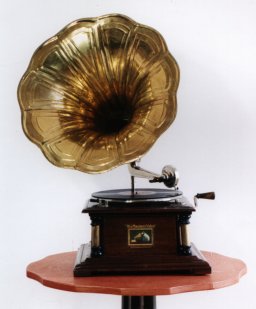Gramophone
| In 1887 Emile Berliner had his playback until, the gramophone, patented. It represented an essential development of the phonograph and served as a basis for modern sound industry. |  |
|
Instead of a cylinder Berliner used a board and replaced the vertical movement of the pin by a horizontal movement. The needle no longer swung down- and upward but lateral in a horizontal groove ("side script"). When extended the sound tracks on the board, the record, appeared to be liked wavy lines with a different amplitude and frequency. This technique remarkably improved the sound quality. |
| In the course of further development a saphire was used instead of the former needle, and its movements altered a thin crystall boardn (eg made of seignette salt).The elastic alterations produced small electric tensions on the board. They were electrically amplified and led to loundspeaker whose membrane was started oscillating, and these oscillations were transferred into the air. Today we call such an apparatus "record player". |
 |